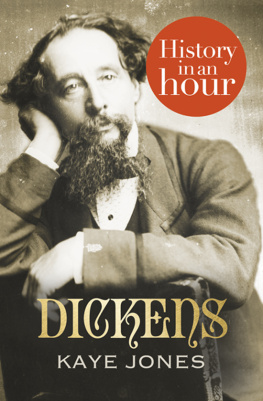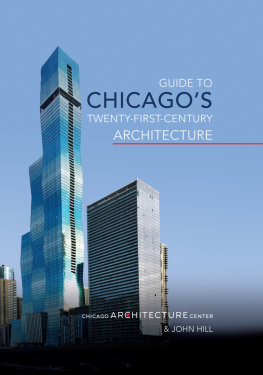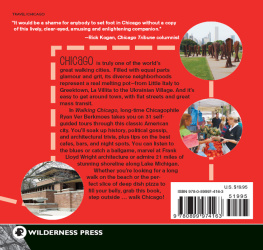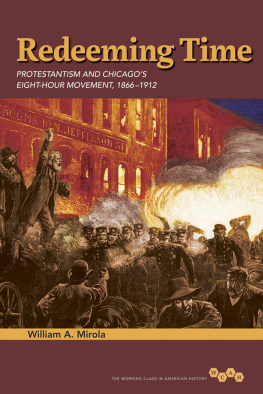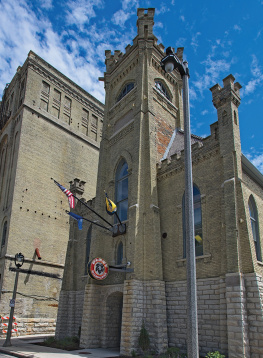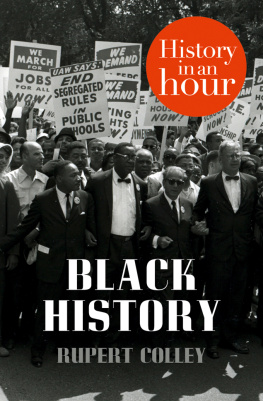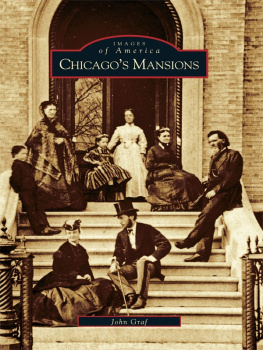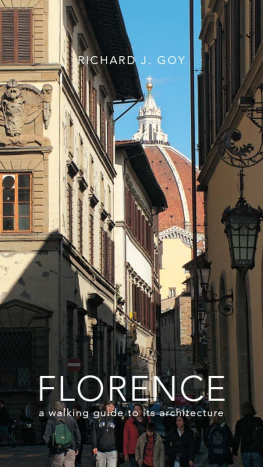Acknowledgments
Thanks to Chicago for being so fascinating.
Thanks to Joan Friedman, upon whose idea this book is based. Dean Berry for all his excitement and encouragement while I was writing this book. Unfortunately he didnt live to see the final publication.
Charmaine Stilinovich for sharing her expert knowledge of writing. Lilly Ghahremani, whose help and advice was invaluable.
Kara Loring of the Museum of Contemporary Art; Lisa Dorin, Erin Hogan, Adrienne Jeske, and Aimee Marshall of the Art Institute of Chicago; Christina Jimenez of the National Museum of Mexican Art; C. J. Lind of the Smart Museum of Art; Gillian Powers of the Arts Club of Chicago; the Richard Gray Gallery; Chris Roberts of the National Vietnam Veterans Art Museum; Ann Belletaire of the Second Presbyterian Church; Dan Roush of Vinci-Hamp Architects; Gabby Weems of the Regional Transportation Authority; Laurie Domenico of the Arthur Freed Company; Mark Igleski of McGuire Igleski Associates; Patrick Bunetta, Sam and Lenore Darin, Elissa and Jeff Feldman, Howard Friedman, Sunny Gold, Ron Gordon, Elise Kapnick, Connie Kieffer, Mary Kostelny, Debbie and Peter Leeb, Leo Leventhal, Colin Reeves, Nancy Robertson, Hank Stein, John Vranicar, Lawrence Ware, and John Warsaw.
Special thanks to Ivan Dee for having the faith to publish this book and for his wise advice, and to Stephanie Frerich, managing editor at Ivan R. Dee, for her careful editing and her cheerful help in answering my endless questions.
A. S.
Chicago
March 2008
Other Sites to See In and Around Chicago
Chicago is such a large city that its difficult to see everything. This books tours were chosen to fit within prescribed time boundaries. Some of the citys art and architecture could not be conveniently seen in any of the hour-long tours. Here are some other highlights of Chicago and areas not previously covered that you may wish to explore.
McCormick Place at 2301 S. Lake Shore Dr. is the huge convention building on the lakefront. The original Mc-Cormick Place burned down in 1967; the current Miesian-type building, with a trussed roof and recessed glass walls, was built in 1971 by C. F. Murphy Associates. It is enormous but built low so as not to compete with the lake. The simple, well-proportioned building covers 19 acres and is pleasing to look at. Inside, the visitor may become disoriented and confused because of the overwhelmingly large and less-than-humanistic space. A second building, McCormick Place North, was added to the complex in 1986 to accommodate growing convention business. This gargantuan structure looms over cars headed south on S. Lake Shore Dr. It was designed by Skidmore, Owings and Merrill and is not as visually successful as its partner on the lake. McCormick Place South , built by Thompson, Ventulett, Stainback and Associates in 1996, is more graceful and has won many awards. McCormick Place West , designed by the same firm and built in 2007, is more pleasing to the eye. A tunnel will recycle rainwater from the roof of the building into Lake Michigan. It is gigantic, built of glass and concrete, but in spite of its great size it appears more friendly and welcoming than its relatives.
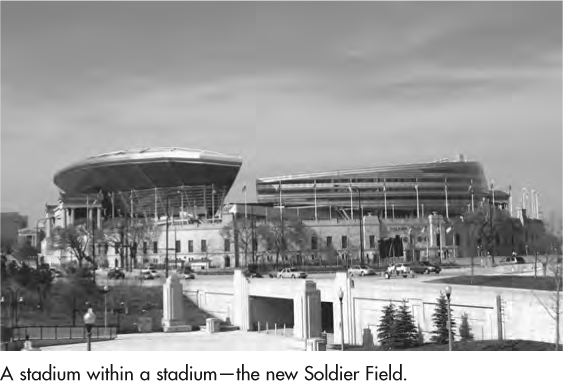
In this same vicinity is Soldier Field at 1410 S. Museum Campus Dr. This GRECO-ROMAN, Doric -style, colonnaded stadium was built in 1926 by Holabird and Roche as a monument to the veterans of World War I. In 2003, frustrated in their efforts to tear down the landmark building, the City of Chicago and the Chicago Bears football team (which plays at Soldier Field) commissioned Wood and Zapata with Lohan, Caprile, Goettsch and Associates to build a stadium within the existing stadium. The result is described by some as the toilet bowl rising from the columns ; others see it is a UFO about to take off. However you look at it, the new interior has no relationship to the older exterior or to the beautiful Museum Campus nearby. The National Park Service has revoked Soldier Fields inclusion on the National Historic Landmarks list because of the addition.
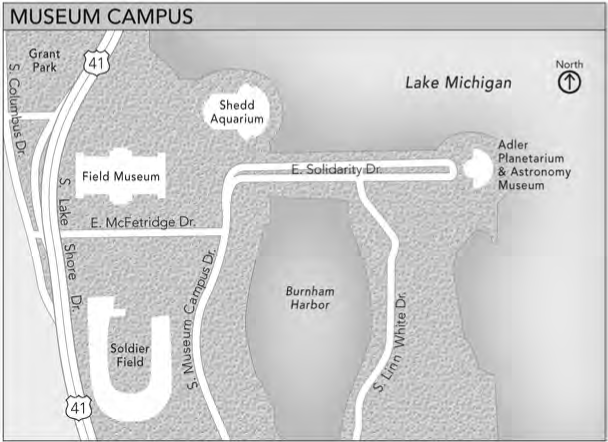
Museum Campus is a lovely parklike campus home to the graceful, NEO-CLASSIC buildings that house three major museums dedicated to the natural sciences: the Field Museum , the Adler Planetarium , and the John G. Shedd Aquarium .
If you are on the Near South Side of the city, you may catch a glimpse of Bertrand Goldbergs River City at 800 S. Wells St. You may have noticed these strange, interesting edifices on the river as you moved about the city. The rounded structures are apartment buildings rising from concrete stilts, reminiscent of but different from Goldbergs Marina City . These constructions, built between 1964 and 1967, were the first attempt to lure more of Chicagos population south of the Loop. Now, many years after River City was built, the Near South Side has become a favorite site for developers and is heavily dotted with condominiums, apartments, houses, and all the shops and restaurants that inevitably follow in their wake. Other Goldberg buildings that bear a resemblance to River City are Northwestern Memorials Prentice Womens Hospital, 333 E. Superior St. (a newer Prentice is at 250 E. Superior St.), and the Hilliard Homes of the Chicago Housing Authority, 2030 S. State St .
If you have an opportunity for a closer look at Lake Point Tower, 505 N. Lake Shore Dr. (see pp. 6870), it is an amazing piece of architecture. It is directly west of that bastion of frantic activity, Navy Pier, but still on the east side of N. Lake Shore Dr.
Just west of Lake Shore Dr. and across from Lake Point Tower, an elegant Santiago Calatrava building that looks like a giant corkscrew is under way. Over 2,000 feet high, about 550 feet taller than Sears Tower, it is another dazzler for Chicago.
The Vietnam Veterans Museum had lost its space at the time of this writing and was searching for a new location. It contained an installation of more than 58,000 dog tags, each imprinted with the name of a soldier killed in the Vietnam War. These tags, the Vietnam War Memorial Wall in Washington, D.C., and a construction by artist Chris Burden, owned by the Museum of Contemporary Art , are the only places to make public a complete list of those who died in Vietnam. The idea for the tags came from Ned Broderick and Richard Steinbock; the design was by Mike Helbing and Joe Fornelli. It is an outstanding and significant work of art. Hopefully this excellent small museum will have established itself elsewhere by the time you read this book. You can check its location on the museums website, www.nvvm.org.
Mies van der Rohes N. Lake Shore Dr. is a perfect example of his INTERNATIONAL STYLE. These vertical, beautifully proportioned, steel-framed, glass buildings done in 1951 create a rhythm of piers and windows that make them transparent sculpture. They are placed on the ground next tobut not even witheach other, creating tension between them. Two companion buildings at and N. Lake Shore Dr. , designed in 1953 and built in 1956, have a darker glass curtain wall . The four buildings standing together are a tribute to MINIMALIST art and architecture. In the 1951 buildings, Mies composed these beautifully idealized buildings but forgot to include the garbage chutes.
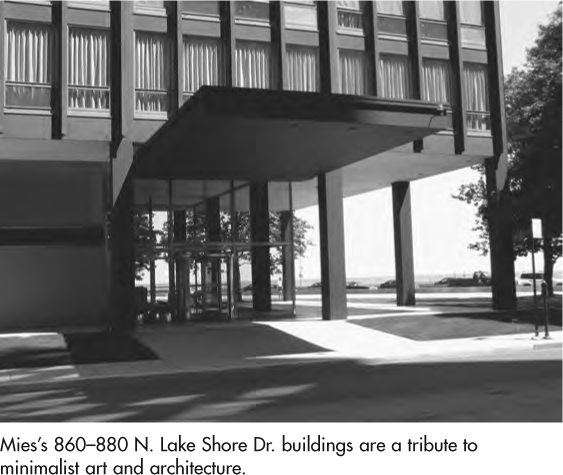
The Harold Washington Library Center at 400 S. State St., by architects Hammond, Beeby and Babka, was the winner in an architectural contest sponsored by the City of Chicago to find a new design for the citys main library. The old library, now the Chicago Cultural Center , was no longer large enough to accommodate Chicagos growing population. Thomas H. Beeby, who had designed a successful regional library at the intersection of Montrose Ave. and Lincoln Ave. (the Conrad Sulzer Library ), as well as the beautiful, cohesive Rice addition at the Art Institute of Chicago , was chosen. His aggressive, in-your-face structure is red brick and granite with small arches at the base, overwhelmed by the very tall arched windows above. The traditional building is topped with a massive green (weathered copper) cornice , sporting gargoyles that are fierce enough to give children nightmares. The north faade with its skin of glass is far more people friendly. The glass is repeated in the pediments . A lovely winter garden is at the top of the building.


